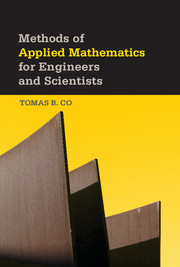Book contents
- Frontmatter
- Contents
- Preface
- I MATRIX THEORY
- III VECTORS AND TENSORS
- 4 Vector and Tensor Algebra and Calculus
- 5 Vector Integral Theorems
- III ORDINARY DIFFERENTIAL EQUATIONS
- IV PARTIAL DIFFERENTIAL EQUATIONS
- A Additional Details and Fortification for Chapter 1
- B Additional Details and Fortification for Chapter 2
- C Additional Details and Fortification for Chapter 3
- D Additional Details and Fortification for Chapter 4
- E Additional Details and Fortification for Chapter 5
- F Additional Details and Fortification for Chapter 6
- G Additional Details and Fortification for Chapter 7
- H Additional Details and Fortification for Chapter 8
- I Additional Details and Fortification for Chapter 9
- J Additional Details and Fortification for Chapter 10
- K Additional Details and Fortification for Chapter 11
- L Additional Details and Fortification for Chapter 12
- M Additional Details and Fortification for Chapter 13
- N Additional Details and Fortification for Chapter 14
- Bibliography
- Index
4 - Vector and Tensor Algebra and Calculus
from III - VECTORS AND TENSORS
Published online by Cambridge University Press: 05 April 2013
- Frontmatter
- Contents
- Preface
- I MATRIX THEORY
- III VECTORS AND TENSORS
- 4 Vector and Tensor Algebra and Calculus
- 5 Vector Integral Theorems
- III ORDINARY DIFFERENTIAL EQUATIONS
- IV PARTIAL DIFFERENTIAL EQUATIONS
- A Additional Details and Fortification for Chapter 1
- B Additional Details and Fortification for Chapter 2
- C Additional Details and Fortification for Chapter 3
- D Additional Details and Fortification for Chapter 4
- E Additional Details and Fortification for Chapter 5
- F Additional Details and Fortification for Chapter 6
- G Additional Details and Fortification for Chapter 7
- H Additional Details and Fortification for Chapter 8
- I Additional Details and Fortification for Chapter 9
- J Additional Details and Fortification for Chapter 10
- K Additional Details and Fortification for Chapter 11
- L Additional Details and Fortification for Chapter 12
- M Additional Details and Fortification for Chapter 13
- N Additional Details and Fortification for Chapter 14
- Bibliography
- Index
Summary
In this chapter, we work with objects that possess a magnitude and a direction. These objects are known as physical vectors or simply vectors. There are two types of vectors: bound vectors, which are fixed to a specified point in the space, and free vectors, which are allowed to move around in the space. Ironically, free vectors are often used when working in rigid domains, whereas bound vectors are often used when working in flowing or flexible domains. We mostly deal with bound vectors.
We denote vectors with underlined bold letters, such as v, and we denote scalars with nonunderlined letters, such as a, unless otherwise noted. Familiar examples of vectors are velocity, acceleration, and forces. For these vectors, the concept of direction and magnitude are natural and easy to grasp. However, it is important to note that vectors can be built depending on the user's interpretation and objectives. As long as a magnitude and direction can be attached to a physical property, then vector analysis can be used. For instance, for angular velocities of a rigid body, one needs to describe how fast the rotation is, whether the rotation is counterclockwise or clockwise, and where the axis of rotation is. By attaching an arrow whose direction is along the axis of rotation, whose length determines how fast the rotation is, and pointing in the direction consistent with a counterclockwise or clockwise convention, the angular velocity becomes a vector. In our case, we adapt the right-hand screw convention to represent the counterclockwise direction as a positive direction (see Figure 4.1).
Information
- Type
- Chapter
- Information
- Methods of Applied Mathematics for Engineers and Scientists , pp. 149 - 203Publisher: Cambridge University PressPrint publication year: 2013
